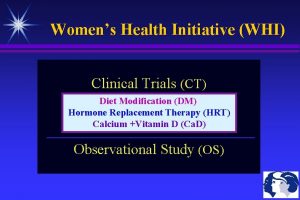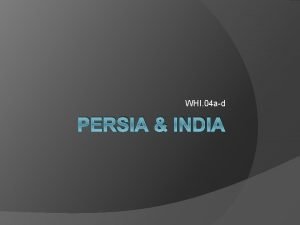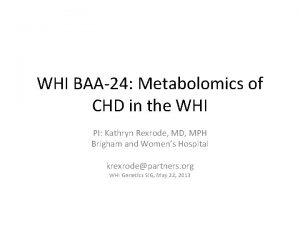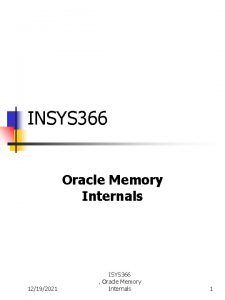366 The Womens Health Initiative WHI Two Decades


























- Slides: 26

366. The Women’s Health Initiative (WHI): Two Decades of Knowledge Ready for Dissemination: Cancer Marian L Neuhouser, Ph. D, RD

Disclosures Marian L Neuhouser, Ph. D, RD • Board Member/Advisory Panel ⎻ American Society for Nutrition (Past-President 2017 -18) ⎻ Member, 2015 Dietary Guidelines Advisory Committee • Consultant ⎻ None • Employee ⎻ Fred Hutchinson Cancer Research Center, Seattle, WA ⎻ University of Washington, Seattle, WA • Research Support ⎻ National Institutes of Health: NIDDK, NCI, NHLBI • Speaker’s Bureau ⎻ None • Stock/Shareholder ⎻ None

Learning Outcomes • Understand the relationship between nutrition and cancer risk in postmenopausal women • Describe how various research study designs can answer different questions about nutrition and health • Describe the initial and follow-up analyses for breast and colorectal cancer in the WHI Dietary Modification Trial • Describe selected findings for diet and cancer risk in the WHI Observational Study

Common cancers in postmenopausal women

Cancer is a complex disease

Relationship of nutrition with carcinogenesis

Cancer Prevention • Lifestyle factors, including diet, are responsible for about 30% of all cancers • Diet influences carcinogenesis at several points in the disease process • Weight, particularly overweight and obesity, are linked to nearly every common cancer in both men and women Can research guide practitioners in implementing cancer prevention for their clients and patients?

Research Study Designs • Different study designs answer different questions • Randomized Controlled Trials: ⎻ Test a single (or at most two) intervention • • • Intervention is assigned (controlled) by investigators A dietary modification A dietary supplement Follow-up is relatively short (5 to 10 years) Analysis compares intervention to control Cause-effect inference/highest level of evidence • Observational Study ⎻ Gathers data from a large group at baseline ⎻ Follows over time to evaluate disease incidence ⎻ Real world, usual habits of people, longer follow-up • WHI had both an RCT and an Observational Study

RCT and Cohort Study Designs

WHI Dietary Modification Trial • Tested the hypothesis that a low-fat dietary pattern (vs no diet change) would reduce incidence of invasive breast cancer and colorectal cancer as primary outcomes • Testing 20% vs. 40% energy from fat plus > 5 fruit and vegetables serving/d • Assumptions were that breast cancer incidence would be 14% lower in intervention vs comparison • Mammography required every 2 years • Participants self-reported new clinical outcomes, including cancers twice yearly. Adjudicated with medical records.

Hazard Ratio for Breast Cancer Prentice et al JAMA 2006

Hazard Ratio for Colorectal Cancer Beresford et al JAMA 2006

What happens post-intervention? • During post-intervention follow-up (+ 5. 2 years), no effects on either breast or colorectal cancer incidence or cancer mortality. • Both incidence and mortality were lower in the intervention vs. comparison, but not statistically different. C Thomson et al Cancer Epi Biomarkers Prev 2014 • After additional follow-up (16. 1 years), lower death after breast cancer (22% ↓; statistically significant) R Chlebowski et al J Clin Oncol 2017

Important points! • In the WHI-DM, significant reduction in breast cancer was linked to: ⎻ Trial adherence – those who were more ‘adherent’ had a 15% lower risk of breast cancer ⎻ Baseline diet - participants who started the trial at a higher baseline percent energy from fat (> 36. 8% energy from fat) – 22% reduction in breast cancer risk ⎻ R Prentice et al JAMA 2006 • Colorectal polyps 9% lower in intervention vs comparison ⎻ Statistically significant. ⎻ Polyps are a precursor lesion for colorectal cancer ⎻ S Beresford et al JAMA 2006 Cancer is a complex disease that takes many years to develop (15 -20 yrs); an RCT may be too short

Nutrition and Cancer in the Observational Cohort Setting • Are general population guidelines for cancer risk reduction effective? • We examined the American Cancer Society (ACS) Nutrition and Physical Activity Cancer Prevention Guidelines in relation to cancer risk and mortality in the WHI-OS • ACS guidelines give a score of 0 -8 from a combined measure of diet, physical activity, BMI and alcohol C Thomson et al Cancer Prev Res 2014

ACS Healthy Lifestyle Scoring Criteria Worst Score (0) Middle Score (1) Best Score (2) 1. Maintain a healthy weight throughout life BMI > 30 kg/m 2 BMI 25 -29. 9 kg/m 2 BMI<25 kg/m 2 2. Adopt a physically active lifestyle - > 30 minutes moderate-vigorous PA at least 5 d/wk. 45 -60 min better <8. 75 MET hr/wk 8. 75 -17. 5 MET hr/wk <17. 5 MET hr/wk 3. Consume healthy diet with emphasis on plant sources 0 -2 diet points 3 -6 diet points 7 -9 diet points 3 a. Eat > 5 fruit +vegetable/d from a variety of sources 1 point for > 5 svg/d fruit +veg, + 1 or 2 points for being in 2 nd or 3 rd Q of serum carotenoids 3 b. Choose whole grains over refined/ processed % of grains consumed as whole grains; divided into quartiles and assigned score of 0 -3 3 c. Limit consumption of red and processes meats Svgs/wk of red/processed meat divided into quartiles and assigned score 0 -3 (reverse score) 4. If you drink, limit to 1/d >0 -<1/d Non-drinker

Methods • 93, 676 postmenopausal women in the WHI-OS • Women were excluded from this analysis ⎻ Prior history of cancer ⎻ Underweight, unknown or unreliable BMI ⎻ Missing data on diet, physical activity or outcomes • Analytic cohort = 65, 838 • ACS scores for each participant were created from baseline food frequency questionnaire and recreational physical activity assessment. Height and weight measured at WHI study visits. • Cox proportional hazards models estimated multivariate-adjusted association across tertiles of ACS scores with cancer risk and cancer mortality

Results • Higher vs. lower ACS scores: ⎻ ⎻ 17% lower risk of any cancer 22% lower risk of breast cancer 52% lower risk of colorectal cancer No associations for endometrial, ovarian or lung cancers • Higher vs lower ACS scores: ⎻ 27% lower death from any cause ⎻ 20% lower total cancer death ⎻ 41% lower colorectal cancer death ⎻ C Thomson et al Cancer Prev Res 2014

Diet Quality in the WHI-OS • Diet quality measures the whole diet; diet is complex and people eat foods, not nutrients • “The quantities, proportions, variety or combination of different foods, drinks, and nutrients (when available) in diets and the frequency with which they are habitually consumed” Nutrition Evidence Library. A Series of Systematic Reviews on the Relationship Between Dietary Patterns and Health Outcomes. U. S. Department of Agriculture, Center for Nutrition Policy and Promotion, March 2014. Scientific Report of the 2015 Dietary Guidelines Advisory Committee • Diet quality is assessed with scoring systems such as the “Healthy Eating Index” that assess adherence to the US Dietary Guidelines

Diet Quality & Mortality in the WHI-OS Postmenopausal women (50 -79 yrs) at 40 US clinical centers 93, 676 in WHI OS. 63, 805 in this analysis after excluding baseline CVD, Cancer, DM Enrollment 1993 -1998 9 -30 -2010 ~12. 9 years follow-up Baseline WHI-FFQ and demographic and lifestyle questionnaires Weight, height, and waist circumference measured in clinic Vital status updated annually, cause of death confirmed with medical records S George et al Am J Epi 2014

Methods • Calculated HEI, AHEI, a. MED, & DASH scores • Points are given (or not) for consumption of fruit, vegetables, whole grains, legumes, low-fat dairy, lean meat, fish. No points for SSB, added sugars, trans fat, saturated fat. • Slight variations between scoring systems • Estimated multivariate hazard ratios and 95% confidence intervals for death • Subgroup analyses by BMI and waist circumference

Results • 5, 692 deaths over 12. 9 years of follow up [CATEGOR Y NAME], [VALUE]

Hazard Ratios (95% CI) for Mortality According to Quintiles (Q 5 vs. Q 1) of Diet Quality Indices All Cause CVD Cancer ü Adjusted for age, race/ethnicity, education, marital status, physical activity, smoking, energy, body mass index, alcohol (HEI and DASH only), hormone therapy. George et al Am J Epi 2014

By BMI status: Cancer Mortality <25 kg/m 2 (n=26, 551) 25 -29. 9 kg/m 2 (n=21, 628) 30+ kg/m 2 (n=14, 936) ü Adjusted for age, race/ethnicity, education, marital status, physical activity, smoking, energy, alcohol (HEI and DASH only), hormone therapy. S George et al Am J Epi 2014

Practice Applications • RDs and RDNs played a crucial role in the delivery and implementation of the largest dietary intervention trial ever conducted in postmenopausal women • In the WHI Dietary Modification Trial, we found a modest, but not significant reduction in breast cancer risk. The signal was stronger in women who started the study with a higher fat intake and among the ‘adherent’. • In the WHI Observational Study, over the long term, postmenopausal women who followed a diet consistent with ACS guidelines and other healthy diet indicators had significantly lower cancer risk and cancer mortality • RDs and RDNs can guide clients and patients in making healthy food choices that should be maintained long-term for the maximum health benefit • Cancer takes years to develop; healthy diet should be followed throughout the life course

Thank you Special thanks to WHI Investigators and the Dietary Patterns Methods Project.
 One step forward two decades back
One step forward two decades back Green orange yellow
Green orange yellow Whi format
Whi format Whi
Whi Opwekking 366
Opwekking 366 366 rounded to the nearest ten
366 rounded to the nearest ten Ps 366
Ps 366 Pobble 365 a dangerous pet
Pobble 365 a dangerous pet 98 366
98 366 98 366
98 366 Na jednom kraju bakrene cijevi duljine 366 m
Na jednom kraju bakrene cijevi duljine 366 m Decades project
Decades project Last decades art
Last decades art Needs of adolescence
Needs of adolescence Womens rights
Womens rights Late night womens hour
Late night womens hour Aylesbury womens aid
Aylesbury womens aid Womens right
Womens right Differences between men's and women's soccer
Differences between men's and women's soccer Womens college kumbakonam
Womens college kumbakonam Womens college kumbakonam
Womens college kumbakonam Womens right
Womens right Womens shelter edmonton
Womens shelter edmonton Women's rights
Women's rights Womens anatomy diagram
Womens anatomy diagram Womens history month door
Womens history month door Womens community shelters
Womens community shelters


















































